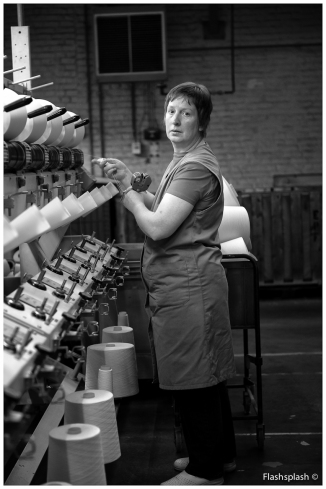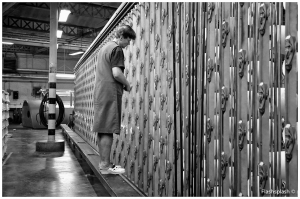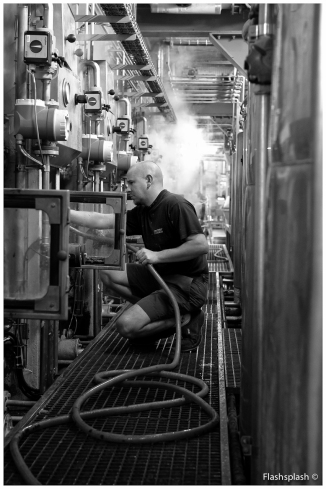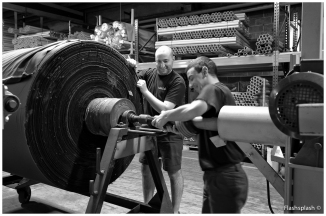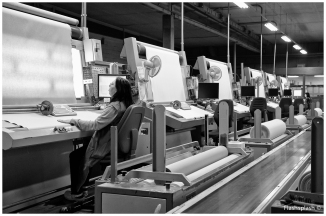Industrial Photography “ The Blue collar workers”
Recently a friend of mine asked me to shoot pictures in a textile factory, depicting the process of textile production. The textile industry was since the Middle Ages the cornerstone of the Flemish industry and has always been very labor intense. The last decennia, taxation on labor became extremely high. In order to survive, many factories relocated to third world countries, where taxes and wages are exceptionally low. Never the less, the hard core stayed and is now specialized in high tech textiles. One of those factories is “UTEXbel”.
Shooting pictures in a working factory is a very difficult task, more so since I had no control over the light, movements and poses. It is kind of shooting with what you have, while been alert to potential danger zones. I insisted to do “my thing” in total freedom. Yes , I could take shots of the machinery and the production process. However, I believe that the most important resource of an organization or business is people. Indeed the blue-collar workers, people that work in shifts around the clock and finally produce materials and products. Slick managers of all sorts, accountants, you name it, are what I call administrative overhead. Producing nothing else then paper, sure we need them. However nowadays it has gone to far. So, I planned to have in every picture a blue-collar worker.
It all starts with Spinning.
Truckloads of reels with loosely spun roving arrive daily at the spinning complex. Rows and rows of spinning machines takes the roving, thins it and twists it, creating yarn winded onto a bobbin. Rows and rows of machinery orchestrated by the “spinster”. A repetitive cycle of catching the roving, attach and detach the bobbin. The question is “who drives who?”. When I took these pictures there was no time for a chat, as the spinsters were serving one spinner after the other.
Winding
Hundreds of yarn (fine strings) bobbins now need to be winded onto large metal reels so that it can be used in the weaving process. A tedious job assigned to “Prep Girls”. They are responsible for placing the single bobbins on the holding frames and shoot with compressed air the very thin yarn to the winder. Keeping a close eye on any loose or broken wires. When the yarn bobbins run empty they must arrange for a new load. Moments of intense work, interrupted with short moments of very short-lived relaxation.
Weaving
The dried and burned reels of yarn are feeding the weaving machines as the loom. The length way threads are known as the warp, and the crossway threads are known as the weft. The weft passes across the loom in a shuttle, carrying the yarn on a pirn. Sounds all very complicated, but it is not.
The weaving room by itself is extreme large and noisy room. The floor trembles on the rhythm of the machinery. The “weavers” roam between dozens of machines. When the weaving stops, it is the “weavers” job to come to the rescue. A broken warp thread, broken weft thread, the shuttle not going straight across, or an empty shuttle requires a skilled worker to act in a timely manner. I have been watching those men, they are absolutely incredible handy. There hands flash through the loom, picking up thin wire and making miniscule nuts.
High density weaving is a very special technique and used in Kevlar , special trained “weavers” are working the “beast” as they call it. The beast uses over a thousand thin wires in the weaving process, and only very skilled weavers can master the machinery
Finishing- it up
The woven fabric in its loom-state does contain impurities, including warp size and requires further treatment in order to develop its full textile potential. That is why the “ arrangers” will take the woven fabric through multiple processes, until the final product is created.
Desizing
The cloth may is steeped in a dilute acid and then rinsed, or soaked in enzymes to break down the size under thigh control of the operator. This might sound strange but a much needed process.
Scouring
The cloth is boiled under pressure in iron vessels at high temperature enriched with alkali so that all natural wax and non-fibrous impurities such as seed fragments, soiling or dirt are removed. Not such a pleasant area to work, as the humidity and temperature are fairly high, no wonder that the workers are working in shorts and T’s. By now even the most naturally white cotton is yellowish, and bleaching, the next process, is required.
Bleaching
Bleaching improves whiteness by removing natural coloration and remaining trace impurities from the cotton. This wet process is controlled and altered depending on the final purpose of the cloth. For fabric to be dyed a deep shade, lower levels of bleaching will be applied. Operators control the batches. And if you thought they were done, then I have to disappoint you as the work goes on.
Mercerising
Or the swelling of the fibers. This results in improved luster, strength and dye affinity. A senior shift leader told me “Cotton is mercerized under tension, and all alkali from the previous processes must be washed out before the tension is released or shrinkage will take place”. I took it for granted and kept flowing the process.
Singeing & Raising
Marcel a older employee is the master of the the big stove. “Here we are getting close to the final product, however the fabric has to pass the big stove” . “It burns off the surface fibers from the fabric to produce smoothness. We tickle it with brushes to raise the fibers, then pass it over a plate heated by gas flames”. But some like it fluffy , hence a raising finishing process is needed. During rising, the fabric surface is treated with sharp teeth to lift the surface fibers, thereby creating hairiness, softness and warmth, as in flannelette. No wonder they called it “Ons flanneleke” .
Calendering
If you like it smooth or polished then we apply “Calendering” a mechanical process, in which the fabric is passed between heated rollers to generate smooth, polished or embossed effects depending on roller surface properties and relative speeds.
Shrinking
Finally we arrive at “shorty”, mechanical shrinking, whereby the fabric is forced to shrink width and/or lengthwise. It creates a fabric in which any residual tendency to shrink after subsequent laundering is minimal.
Inspection
On my question if they have any QA, the answers was very short “ what do you think?”, and within seconds I was lured into the QA room. Each square centimeter is scanned by the human eye for imperfections. Those are marked and if possible removed. Girls stare at miles and miles of cloth rolling by. The only thing that can stop it, is an error. A most welcome break in of the monotone process. Ingrid, a QA girl stated “ imperfections make it workable” . Something to think about.
Dyeing
Finally, the cloth is ready to get its color. Dyeing is carried out by completely immersing the fabric in an aqueous dye bath.I was really surprised to see how many times my shirts have been washed and dried before they end-up in the store
Measuring
And finally all the cloth and textile has been created, ready to be sold. The “measurer” is the worker who measures the cloth as per order and places the last hand.
It has been a very interesting shoot, difficult, hot, humid and dusty. There has been days that I hated my daytime job in the office, but oh boy if I see these brave people at work then I am happy to have an office job.
Special thanks to the UTEXbel shift and administration.
Thanks for reading,
Steve




